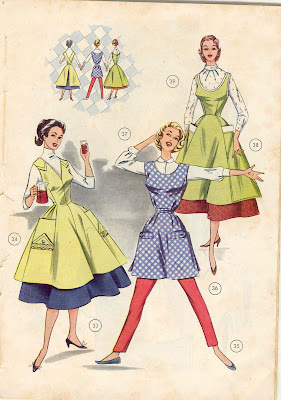I like Nancy Ziemans ideas for starting a sewing project. It helps to brake up your sewing time into little snatches. We are all so busy I find this format the best for me.
1) Look over the pattern. Did you make each piece?
a. Lay the paper patterns together as they would fit and see if all are fitting together OK.
Walk sleeves into armscyes etc.
3) Cut out the fashion fabric adding seam allowance and hems.
Once all this is finished you are ready for the sewing steps.
WARNING: you must add seam allowances and hems on all Lutterloh patterns before cutting.

Facings:
Facings are shown on the pattern with the hatch marks as below and an ST written in the area. Some hatch marks work as interfacing some tell us to roll the fabric around for a self finish. It may surprise you that you will often make the choice as to what way you use a facing mark.
You can trace, with see-through paper, the area for a pattern piece labeled facing. Can you find the facings in the patterns below? I would leave my finished pattern taped to my table and lay a 2nd piece of paper over the area with facing marks and trace them. Some have measurements you can just cut from.

I see facings on the coat front only. The front and back and on the pant waist band would be interfacing in my thinking. The hatch marks on the knit top are just turned under facings Another point of interest is the two piece sleeve. See the one cross but two arrows? Draw it as one, cut it as two. It is a coat after all and the sleeve are usually two pieces. See anything I missed?
*************************************************
Nancy calls this next step
ORGANIZE
1. Did you pre-treat your fabric
2. Do you have your scissors, pattern weights, rulers for seams, thread, buttons, zippers, hemming materials etc. I dump them into a plastic box or bag. Keep it on hand for the project.
3. Mark your pattern pieces for the darts, the hems, buttons, etc. You may like to mark with chalk on the wrong side or you might use pins. What ever marking method works best for you. Before I cut out fabric I will often put a safety pin on each piece to show the front of the fabric.
4. Test and apply fusible interfacing.
5. Set up your machine for sewing.
6. Sew facings and linings, this includes iron in facings
WARNING: you must add your seam allowances to everything! I prefer 1/2 seams use what ever works for you. Don't forget your hems
Once all the facings are in you can proceed to the step by step part
let's do pants first because I think they are the hardest to do.
******************************************************
Pants
1) do everything you can do while the pants are flat
a. sew darts, press toward the center
b. put in pockets, put in belt loops
c. put in zipper
d. press hems (yes on each piece)
2) Put the pant pieces together
a. Stitch the side seams front to back
b. Stitch the inner leg seams front to back, press seams allowances toward the back.
c. Sew the crotch curve from the center back at the waist to the zipper opening
3) Waist and Hems
a. Fold the hem and sew using what ever technique you wish
b. Make and sew in waist band, or turn waist band for elastic use. Pattern notes elastic, otherwise use a faced band.
c. add waist snap, hooks, or sew close opening for elastic.
Press everything and if you have a trouser you will have pressed the center fold before sewing.
All done!
It's just that easy.
Ann's note - A few details I tend to forget when sewing without directions:
1.stay stitch curved pattern pieces after cutting to avoid stretching of the bias
2.clip curves and grade seam allowances before pressing facings
3.under stitch facings and secure to seam allowances to keep them from rolling outward
